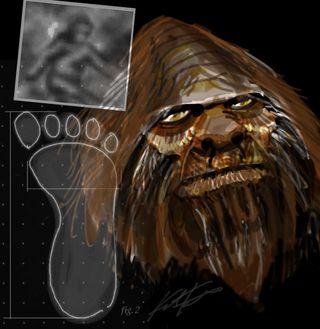The Yeti: Asia's Abominable Snowman

The Yeti, once better known as the Abominable Snowman, is a mysterious bipedal creature said to live in the mountains of Asia. It sometimes leaves tracks in snow, but is also said to dwell below the Himalayan snow line. Despite dozens of expeditions into the remote mountain regions of Russia, China and Nepal, the existence of the Yeti remains unproven.
The Yeti is said to be muscular, covered with dark grayish or reddish-brown hair, and weigh between 200 and 400 lbs. (91 to 181 kilograms) It is relatively short compared to North America's Bigfoot, averaging about 6 feet (1.8 meters) in height. Though this is the most common form, reported Yetis have come in a variety of shapes.
History of the Yeti
The Yeti is a character in ancient legends and folklore of the Himalaya people. In most of the tales, the Yeti is a figure of danger, author Shiva Dhakal told the BBC. The moral of the stories is often a warning to avoid dangerous wild animals and to stay close and safe within the community.
Alexander the Great demanded to see a Yeti when he conquered the Indus Valley in 326 B.C. But, according to National Geographic, local people told him they were unable to present one because the creatures could not survive at that low an altitude.
In modern times, when Westerners started traveling to the Himalayas, the myth became more sensational, according to the BBC. In 1921, a journalist named Henry Newman interviewed a group of British explorers who had just returned from a Mount Everest expedition. The explorers told the journalist they had discovered some very large footprints on the mountain to which their guides had attributed to "metoh-kangmi," essentially meaning "man-bear snow-man." Newman got the "snowman" part right but mistranslated "metoh" as "filthy." Then he seemed to think "abominable" sounded even better and used this more menacing name in the paper. Thus a legend was born.
In her book "Still Living? Yeti, Sasquatch, and the Neanderthal Enigma" (1983, Thames and Hudson), researcher Myra Shackley offers the following description, reported by two hikers in 1942 who saw "two black specks moving across the snow about a quarter mile below them." Despite this significant distance, they offered the following very detailed description: "The height was not much less than eight feet ... the heads were described as 'squarish' and the ears must lie close to the skull because there was no projection from the silhouette against the snow. The shoulders sloped sharply down to a powerful chest ... covered by reddish brown hair which formed a close body fur mixed with long straight hairs hanging downward." Another person saw a creature "about the size and build of a small man, the head covered with long hair but the face and chest not very hairy at all. Reddish-brown in color and bipedal, it was busy grubbing up roots and occasionally emitted a loud high-pitched cry."
It's not clear if these sightings were real, hoaxes or misidentifications, though legendary mountaineer Reinhold Messner, who spent months in Nepal and Tibet, concluded that large bears and their tracks had often been mistaken for Yeti. He describes his own encounter with a large, unidentifiable creature in his book "My Quest for the Yeti: Confronting the Himalayas' Deepest Mystery" (St. Martin's, 2001).
In March 1986, Anthony Wooldridge, a hiker in the Himalayas, saw what he thought was a Yeti standing in the snow near a ridge about 500 feet (152 meters) away. It didn't move or make noise, but Wooldridge saw odd tracks in the snow that seemed to lead toward the figure. He took two photographs of the creature, which were later analyzed and proven genuine.
Many in the Bigfoot community seized upon the photos as clear evidence of a Yeti, including John Napier, an anatomist and anthropologist who had served as the Smithsonian Institution's director of primate biology. Many considered it unlikely Wooldridge could have made a mistake because of his extensive hiking experience in the region. The following year, researchers returned to where Wooldridge had taken the photos and discovered that he had simply seen a dark rock outcropping that looked vertical from his position. It was all a mistake — much to the embarrassment of some Yeti believers.
Yeti evidence?
Most of the evidence for the Yeti comes from sightings and reports. Like Bigfoot and the Loch Ness monster, there is a distinct lack of hard proof for the Yeti's existence, though a few pieces of evidence have emerged over the years.
In 1960, Sir Edmund Hillary, the first man to scale Mt. Everest, searched for evidence of the Yeti. He found what was claimed to be a scalp from the beast, though scientists later determined that the helmet-shaped hide was in fact made from a serow, a Himalayan animal similar to a goat.
In 2007, American TV show host Josh Gates claimed he found three mysterious footprints in snow near a stream in the Himalayas. Locals were skeptical, suggesting that Gates — who had only been in the area for about a week — simply misinterpreted a bear track. Nothing more was learned about what made the print, and the track can now be found not in a natural history museum but instead in a small display at Walt Disney World.
In 2010, hunters in China caught a strange animal that they claimed was a Yeti. This mysterious, hairless, four-legged animal was initially described as having features resembling a bear, but was finally identified as a civet, a small cat-like animal that had lost its hair from disease.
A finger once revered in a monastery in Nepal and long claimed to be from a Yeti was examined by researchers at the Edinburgh Zoo in 2011. The finger generated controversy among Bigfoot and Yeti believers for decades, until DNA analysis proved that the finger was human, perhaps from a monk's corpse. [See also: Bigfoot & Yeti DNA Study Gets Serious]
Russian search for Yeti
The Russian government took an interest in the Yeti in 2011, and organized a conference of Bigfoot experts in western Siberia. Bigfoot researcher and biologist John Bindernagel claimed that he saw evidence that the Yeti not only exist but also build nests and shelters out of twisted tree branches. That group made headlines around the world when they issued a statement that they had "indisputable proof" of the Yeti, and were 95 percent sure it existed based on some grey hairs found in a clump moss in a cave.
Bindernagel may have been impressed, but another scientist who participated in the same expedition concluded that the "indisputable" evidence was hoaxed. Jeff Meldrum, a professor of anatomy and anthropologist at Idaho State University who endorses the existence of Bigfoot, said that he suspected the twisted tree branches had been faked. Not only was there obvious evidence of tool-made cuts in the supposedly "Yeti-twisted" branches, but also the trees were conveniently located just off a well-traveled trail and hardly in a remote area.
Meldrum concluded that the whole Russian expedition was more of a publicity stunt than a serious scientific endeavor, likely designed to increase tourism in the impoverished coal-mining region. Despite quasi-official claims of "indisputable proof" of the Yeti, nothing more has come of the story.
DNA samples
In 2013, Oxford geneticist Bryan Sykes put out a call to all Yeti believers and institutions around the world claiming to have a piece of Yeti hair, teeth or tissue taken from a sighting. He received 57 samples, 36 of which were chosen for DNA testing, according to University College London (UCL). These samples were then compared with the genomes of other animals stored on a database of all published DNA sequences.
Most of the samples turned out to be from well-known animals, such as cows, horses and bears. However, Sykes found that two of the samples (one from Bhutan and the other from India) were a 100 percent match for the jawbone of a Pleistocene polar bear that lived sometime between 40,000 and 120,000 years ago — a period of time when the polar bear and closely related brown bear were separating as species, according to BBC. Sykes thought the sample was probably a hybrid of a polar bear and a brown bear.
However, two other scientists, Ceiridwen Edwards and Ross Barnett, conducted a re-analysis of the same data. They said that the sample actually belonged to a Himalayan bear, a rare subspecies of the brown bear. Their study results were published in the Royal Society journal, Proceedings of the Royal Society B.
Another team of researchers, Ronald H. Pine and Eliécer E. Gutiérrez, also analyzed the DNA and also concluded that "there is no reason to believe that Sykes et al.'s two samples came from anything but ordinary brown bears."
And in 2017, yet another team of researchers analyzed nine "Yeti" specimens, including bone, tooth, skin, hair and fecal samples collected from monasteries, caves and other sites in the Himalayas and the Tibetan Plateau. They also collected samples from bears in the region and from animals elsewhere in the world.
Of the nine yeti samples, eight were from Asian black bears, Himalayan brown bears or Tibetan brown bears. The ninth was from a dog.
True believers undeterred
The lack of hard evidence despite decades of searches doesn't deter true believers; the fact that these mysterious creatures haven't been found is not taken as evidence that they don't exist, but instead how rare, reclusive, and elusive they are. Like Bigfoot, a single body would prove that the Yeti exist, though no amount of evidence can prove they don't exist. For that reason alone, these animals — real or not — will likely always be with us.
Additional reporting by Traci Pedersen, Live Science contributor.
Additional resources
- BBC: Is the Himalayan Yeti a real animal?
- Bigfoot Encounters: An encounter in Northern India, by Anthony B. Wooldridge
- Committee for Skeptical Inquiry: No Reason to Believe That Sykes’s Yeti-Bear Cryptid Exists
Ever seen Bigfoot's eyeshine in your headlights at night? Heard a splash and sworn you saw Nessie's tail disappearing below the lake surface? Cryptic creatures of myth and legend are known the world over.
Bigfoot, Nessie & the Kraken: Cryptozoology Quiz

Sign up for the Live Science daily newsletter now
Get the world’s most fascinating discoveries delivered straight to your inbox.
